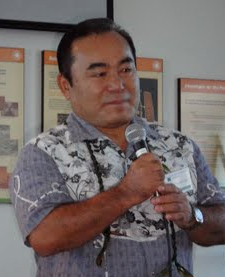U.S. and Okinawan technical, environmental and financial specialists in ocean thermal energy conversion (OTEC) swapped knowledge during a two-day Ocean Energy Workshop at the Natural Energy Laboratory of Hawaii (NELHA) facility.
The goal of the workshop, which ended today (Monday, Sept. 12), was to move OTEC further toward commercialization. Okinawa and Hawaii share a common problem—over reliance on fossil fuels—but also share a common asset in access to big temperature differences between surface and deep ocean waters.
OTEC, which was tested here in the late 1970s and found feasible by the U.S. government, uses these temperature differences to generate electricity. It is an expensive system to build, but can produce power for a band of subtropical and tropical areas around the globe. Cheap oil prevented alternatives such as OTEC from reaching commercialization.
“Our workshop sought to advance effective OTEC systems that can be demonstrated in both Hawaii and Okinawa by sharing technical, environmental and financial challenges,” said Guy Toyama of Friends of NELHA, which organized the workshop. “The Hawaii-Okinawa Task Force was formed as part of the U.S.-Japan Clean Energy Action Plan in 2009, and we’ve been working together since then.”
Okinawa, like Hawaii, is a long way from its nation’s mainland and Kumejima Island is at the most distant point. Both already use deep water pipes to support industry, such as aquaculture and water desalination. “The next steps are farming and energy,” said Kumejima Mayor Choukou Taira. In a ceremony surrounded by Hawaiian culture, Taira and Hawai‘i Island Mayor William Kenoi inked a sister city agreement during the workshop.
The technical specialists debated whether a demonstration or pilot plant should be built, or if incremental research and development steps would be more politically and technically feasible. The workshop participants debated that if a pilot plant were built, should it be the proposed 1megawatt size or something smaller. Commercial plants are expected to be at least 25 megawatts, with plans on the drawing board for 100 MW and located offshore.
Saga University in Japan is conducting extensive OTEC research and seeks to work with Hawaii to develop next stage facilities in Kumejima and NELHA.
Breakout sessions outlined the following challenges and considerations.
Environmental aspects that need to be considered for onshore, the team decided:
Interruption or change of habitats, cultural issues, visual issues, assessment of deep-water nutrient impact, thermal issues and entrainment of organisms in the uptake pipe. Offshore issues—cable impacts, acoustic, visual and navigational impacts.
Technical considerations: No technical barriers to a 1 MW plant, but there are political ones including protecting downstream tenants from contamination.
Financial considerations for a 1 MW plant could include seeking support from the U.S. Department of Defense, a bilateral project with Japan/U.S.; or organizations like Blue Revolution Hawaii becoming a fundraiser.
Policy considerations: Need for healthy competition in the OTEC field; testing as large a scale as possible at NELHA should be entertained.
Workshops between the two countries will continue as part of the Task Force.
Related articles
- Tomorrow the County of Hawaii Will Enter Into a Sister City Relationship with the Island of Kumejima, Okinawa, Japan (damontucker.com)
- Website Promotes Ocean Thermal Energy Conversion (energyrefuge.com)
- Lt. Governor Schatz – “Our Energy Future Is Now” (damontucker.com)
- New concept converts oceans solar energy into low-cost electricity (gcaptain.com)
Filed under: aloha, Announcements, Big Island, Environment, Sustainable Living, Technology | Tagged: Kumejima Island, Mayor Choukou Taira, Natural Energy Laboratory of Hawaii Authority, Ocean thermal energy conversion | 1 Comment »





















